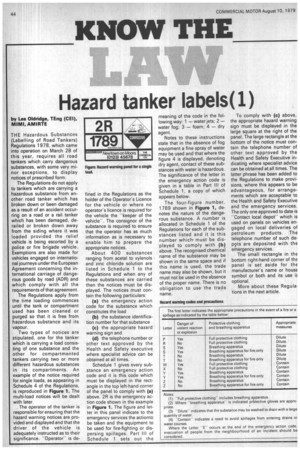Hazard tanker labels(1)
Page 46

If you've noticed an error in this article please click here to report it so we can fix it.
by Les Oldridge, TEng (CEI), MIMI, AMIRTE THE Hazardous Substances (Labelling of Road Tankers) Regulations 1978, which came into operation on March 28 of this year, requires all road tankers which carry dangerous substances, with some very minor exceptions, to display notices of prescribed form.
The Regulations do not apply to tankers which are carrying a hazardous substance from another road tanker which has broken down or been damaged as a result of an accident occurring on a road or a rail tanker which has been damaged, derailed or broken down away from the siding where it was loaded provided the relief vehicle is being escorted by a police or fire brigade vehicle. Exemptions are also made for vehicles engaged on international journeys under the European Agreement concerning the international carriage of dangerous goods by road (ADR) and which comply with all the requirements of that agreement.
The Regulations apply from the time loading commences until the tank or compartment used has been cleaned or purged so that it is free from hazardous substance and its vapour.
Two types of notices are stipulated, one for the tanker which is carrying a load consisting of one substance and the other for compartmented tankers carrying two or more different hazardous substances in its compartments. An example of the notice required for single loads, as appearing in Schedule 4 of the Regulations, is reproduced in Figure 1. The multi-load notices will be dealt with later.
The operator of the tanker is responsible for ensuring that the hazard warning notices are provided and displayed and that the driver of the vehicle is adequately instructed as to their significance. "Operator" is de fined in the Regulations as the holder of the Operator's Licence for the vehicle or where no operator's licence is required for the vehicle the "keeper of the vehicle". The consignor of the substance is required to ensure that the operator has as much information as is necessary to enable him to prepare the appropriate notices.
About 400 substances ranging from acetal to xylenols and zinc chloride solution are listed in Schedule 1 to the Regulations and when any of these substances are carried then the notices must be displayed. The notices must contain the following particulars: (a) the emergency action code for the substance which constitutes the load (b) the substance identification number for that substance (c) the appropriate hazard warning sign and (d) the telephone number or other text approved by the Health and Safety executive where specialist advice can be obtained at all times.
Schedule 1 gives every substance an emergency action code and it is this code which must be displayed in the rectangle in the top left-hand corner of the panel to comply with (a) above. 2R is the emergency action code shown in the example in Figure 1. The figure and letter in this panel indicate to the emergency services the actionto be taken and the equipment to be used for fire-fighting or dispersing spillages. Part Ill of Schedule 1 sets out the meaning of the code in the following way: 1 — water jets; 2 — water fog; 3 — foam; 4 — dry agent.
Notes to these instructions state that in the absence of fog equipment a fine spray of water may be used and that where the figure 4 is displayed, denoting dry agent, contact of these substances with water is hazardous. The significance of the letter in the emergency action code is given in a table in Part Ill of Schedule 1, a copy of which appears below.
The four-figure number, 1789 shown in Figure 1, denotes the nature of the dangerous substance. A number is allocated in Schedule 1 of the Regulations for each of the substances listed and it is this number which' must be displayed to comply with (b) above. The recognised chemical name of the substance may be shown in the same space and if this name is used, the trade name may also be shown, but it must not be used in the absence of the proper name. There is no obligation to use the trade name.
To comply with (c) above, the appropriate hazard warning sign must be displayed in the large square at the right of the panel. The large rectangle at the bottom of the notice must contain the telephone number of other text approved by the Health and Safety Executive indicating where specialist advice can be obtained atall times. The latter phrase has been added to the Regulations to make provisions, where this appears to be advantageous, for arrangements which are acceptable to the Health and Safety Executive and the emergency services. The only one approved to date is "Contact local depot" which is used on panels on vehicles engaged on local deliveries of petroleum products. The telephone number of such dep9ts are deposited with the emergency services.
The small rectangle in the bottom right-hand corner of the panel is set aside for the manufacturer's name or house symbol or both and its use iE optional.
More about these Regula• tions in the next article.




































































































